#philipp stepin
Note
Do you think the MT is having a shortage of male principals? I love Kimin Kim and Vladimir Shklyarov but other than that i'm not obsessed with anyone else :(
Also, would you happen to know why Kimin Kim mostly seems to dance with Tereshkina these days? I loved him with Khoreva!
Definitely, the Mariinsky male principals are at a vulnerable point right now, especially after losing Parish and Caixeta. I love Kim, Shklyarov, and Ivanchenko, but Ivanchenko is practically retired and Shklyarov only has a few more years in him. I'm also not a huge fan of Askerov or Yermakov. I've found Askerov to be kinda awkward in a lot of roles and I've just never gotten into Yermakov.
I think Stepin should totally be a principal and I'd like for him to be promoted to fill things out a bit. However, he's a 2005 grad, so he's not exactly on the younger side either.
I would say that it's likely that eventually Belyakov and Konovalov will be promoted to Principal as well as Korneyev a little later.
They also seem to really be pushing the recent joiner Even Capitaine. I haven't seen a lot of Capitaine yet though, so I can't really speak to him.
As for the question about Kimin Kim's partners recently, I'm not really sure about that. I also really liked him with Khoreva, but perhaps something personal happened between them 🤷♀️🤷♀️. I don't know.
#ballet#mariinsky#yevgeny ivanchenko#vladimir shklyarov#kimin kim#philipp stepin#roman belyakov#yevgeny konovalov#nikita korneyev
9 notes
·
View notes
Photo
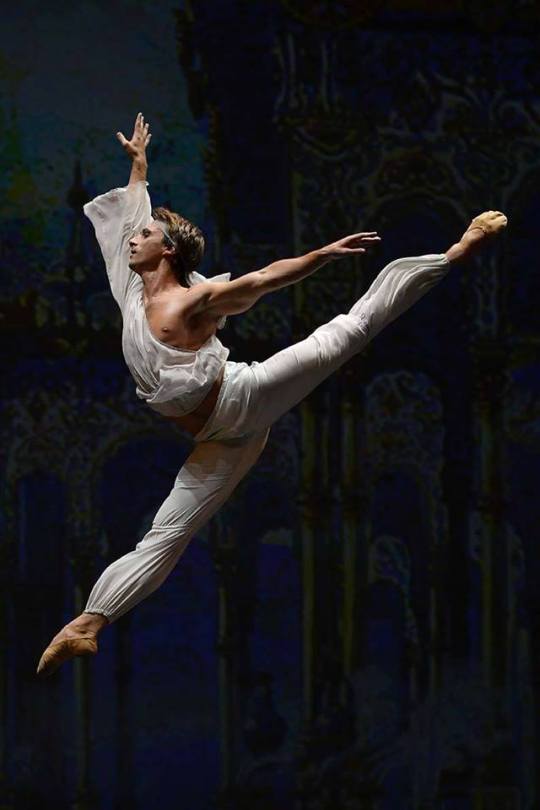
Philipp Stepin - photo by Alain Hanel
#philipp stepin#alain hanel#dance#ballet#boys of ballet#ballet men#dancer#danseur#ballerino#bailarín#tänzer
61 notes
·
View notes
Photo


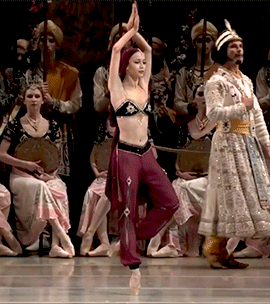
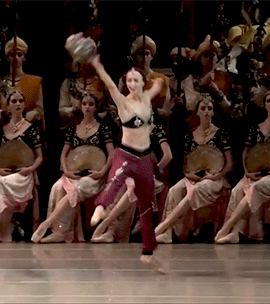


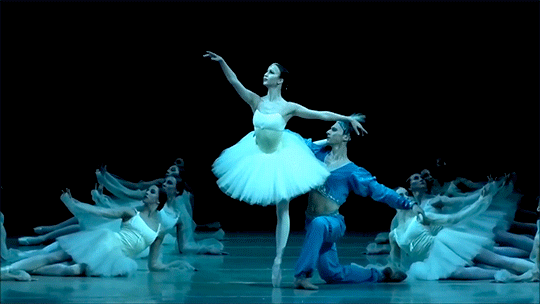
Renata Shakirova as Nikiya in La Bayadere.
Her partner is Philipp Stepin.
This is their second performance and our first video of them in this role.
#renata shakirova#la bayadere#mariinsky ballet#ballet#ballerina#future prima#favorite ballerina#favorite ballet#gif#my gif#ballet gif#philipp stepin#favorite partnership#shakirova gif
29 notes
·
View notes
Text
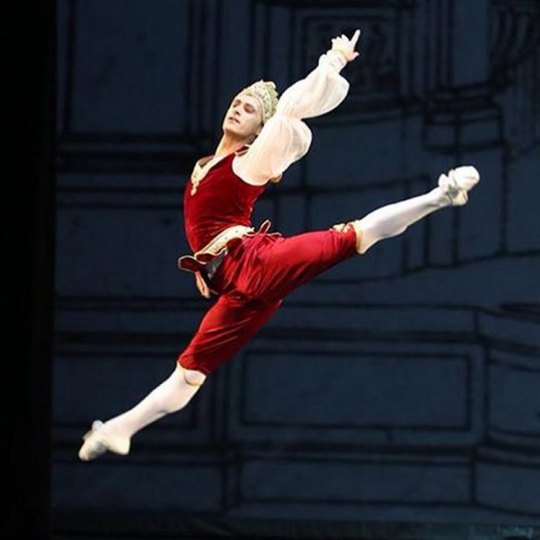

Philipp Stepin | Mariinsky Theatre | Mariinsky Ballet
18 notes
·
View notes
Note
Hi Ale! How was Shakirova's debut as Nikiya?
...You know it went well when the theater makes a video of it.
youtube
I'm so happy for her, she wasn't 'supposed' to do well in this role and she absolutely went on stage and proved everyone wrong. She's so open and vulnerable on stage and she brought that honesty to this role along with technical finesse. In the future, I would like to see some more refined musicality but I was honestly impressed by her stability, confidence, and connection with Stepin.
Also, everyone, don't forget that this was a double debut! I've been on the Promote Philipp train for a while now...but it needs to happen. He has all the roles and the standards of his performance are sky-high. No more waiting around, there is plenty of space for a man to be promoted and it should unquestionably be him
18 notes
·
View notes
Video
youtube
La Spectre de la Rose Philipp Stepin Ksenia Ostreikovskaya
0 notes
Photo
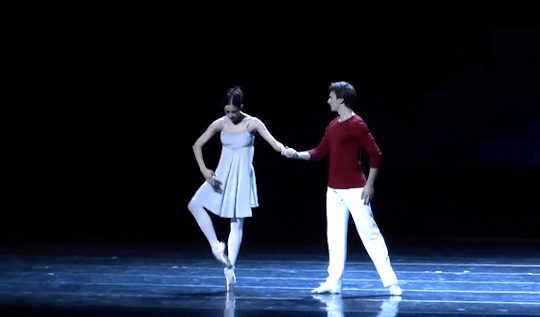
Nadezhda Batoeva and Philipp Stepin in Cinderella (Mariinsky Ballet)
#Nadezhda Batoeva and Philipp Stepin#nadezhda batoeva#Philipp Stepin#cinderella#cinderella ballet#Mariinsky Ballet#alexei ratmansky#ballet#dance#ballerina#dancer#pdd#pas de deux#gif#my gif
69 notes
·
View notes
Photo

Olessia Novikova and Philipp Stepin in The Sleeping Beauty (Mariinsky Ballet)
40 notes
·
View notes
Text

Alina Somova as Juliet and Philipp Stepin as Romeo,, "Romeo and Juliet" choreography by Leonid Lavrovsky, music by Sergei Prokofiev, libretto by Andrian Piotrovsky, Sergei Prokofiev, Sergei Radlov and Leonid Lavrovsky, Mariinsky Ballet (new stage, July 18, 2019) "XXVII Music Festival Stars Of The White Nights", Saint Petersburg, Russia (May 22 to July 21, 2019)
Photographer Natasha Razina
72 notes
·
View notes
Text
Saved by the corps! The Mariinsky under par for Swan Lake in Turin
Philipp Stepin in Swan Lake by Natasha Razina © State Academic Mariinsky Theatre The buzz of anticipation in the theatre wasn’t matched by the Mariinsky Ballet’s presentation on Saturday afternoon in Turin’s Teatro Regio. Maybe because it was the ‘pensioners’ matinée’, the company decided not to field their top players. For the Mariinsky, the performance was under par. The first technical feats…
View On WordPress
1 note
·
View note
Photo
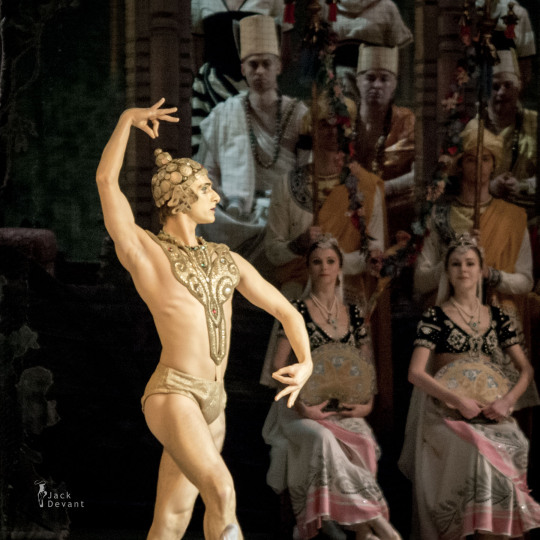
Philipp Stepin - photo by Jack Devant
#philipp stepin#jack devant#dancer#danseur#ballerino#bailarín#tänzer#dance#ballet#boys of ballet#ballet men
25 notes
·
View notes
Photo
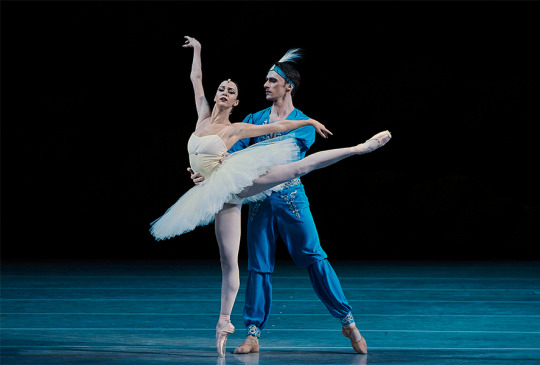
Renata Shakirova and Philipp Stepin in La Bayadere.
Photo from the Mariinsky’s website.
#renata shakirova#philipp stepin#la bayadere#mariinsky ballet#favorite ballerina#favorite ballet#favorite dancer#favorite partnership#future prima#ballet
20 notes
·
View notes
Photo
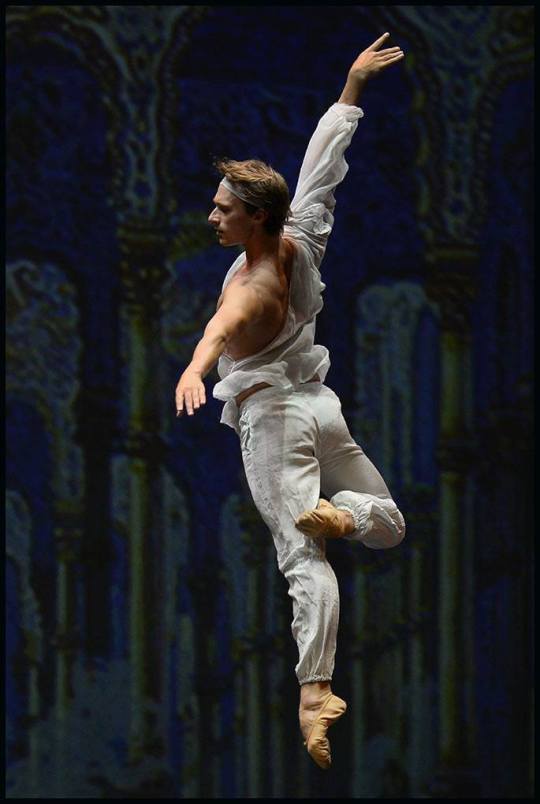
Philipp Stepin | Mariinsky Theatre | Mariinsky Ballet
27 notes
·
View notes
Note
Hi! do you have a Mariinsky vs Bolshoi post? Like a general reviews of both theatres and difference of their dancers and style?
Generalizing here but Moscow (BBA graduates) are known for their explosive, firey technical feats, impactful charisma and acting skills, and just a bold, daring quality of movement. Bolshoi is the bigger theatre in all aspects. It has more money, more dancers, more performances, and an absolutely massive historical stage.
Dancers who I consider good representations of the 'Moscow' style: Natalia Osipova, Ivan Vasilliev, Maria Alexandrova, Vladislav Lantratov

The quintessential Mariinsky (VBA graduates) dancers tend to be softer, more lyrical, soulful and have more 'pure' classical technique. And of course, I have to mention the signature SPB port de bras and fluid upper body. Their dancers tend to be more aloof, almost ethereal, and are less 'dramatic' than their Moscow counterparts.
Dancers to check out: Ulyana Lopatkina, Yulia Makhalina, Igor Zelensky, Nadezhda Batoeva, Philipp Stepin
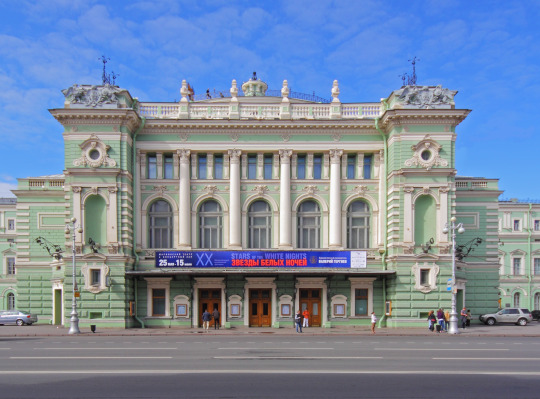
*deliberately tried to name current-ish dancers because I think it's more helpful to see what the 'historical' styles look like on today's ballet aesthetics.
29 notes
·
View notes
Photo

Philipp Stepin in Sylvia - Mariinsky Ballet
photo © Jack Devant
7 notes
·
View notes
Photo

BALLET / 2018-2019
LE CORSAIRE
STUDENT GUIDE
WORKING REHEARSAL
MARIINSKY BALLET
With the Kennedy Center Opera House Orchestra
Original Choreography by Marius Petipa
Reconstructed choreography (1987) by Pyotr Gusev
Music by Adolphe Adan, Cesare Pugni, Léo Delibes, Riccardo Drigo and Pyotr Oldenburgsky
Libretto by Henri Vernoy de Saint-Georges and Joseph Mazilier and edited by Yuri Slonimsky and Pyotr Gusev
School Show: April 9
Teacher and Parent Guide: Le Corsaire
Before the curtain rises, a little history…
Whether or not you’ve touched a tutu or performed a plié, you’ve surely heard of Marius Petipa’s (pronounced PET-ee-pahs) ballets. Does Swan Lake ring any bells? What about Sleeping Beauty? And that holiday classic, The Nutcracker! But here’s the oddest thing: Petipa—born in France—is considered the “Father of Russian Ballet.” How’d that happen?
When Petipa arrived in St. Petersburg, Russia in 1847, he was considered just an “okay” dancer. Decades later, however, he had successfully danced his way up the ladder at the Russian Imperial Theatre. To celebrate this famous choreographer, the Mariinsky Ballet performs Le Corsaire (COUR-sair, The Pirate). Set on an island in Greece, this ballet is filled with exotic characters, a shipwreck, treachery, romance, betrayal, and a boatload of pirates!
About that pirate ballet…
The story of Le Corsaire was loosely adapted from Lord Byron’s poem of the same name. The first production was choreographed by Joseph Mazilier in 1856, but Mariinsky’s version is a reconstruction of Marius Petipa’s choreographic revival about 10 years later.
Now here’s the interesting part: Petipa didn’t just choreograph one production of Le Corsaire. He actually revived it four times—each time adding more pas (pronounced pah, incidental dance variations that don’t necessarily forward the plotline or character development). This shouldn’t come as a big surprise since Petipa was famous for developing the form of the grand ballet—a multi-act production with a fully-developed plot, pantomime acting, and lavish sets and costumes. And you’ll soon see that Le Corsaire absolutely fits that definition.
Who’s Who
Main Characters
Conrad, Birbanto, and Ali: shipwrecked pirates
Medora: the most beautiful woman on the Greek island
Gulnara: Medora’s friend
Lankedem: an evil slave trader
Seid Pasha: a rich sultan
So, What’s Going On?
Prologue: The Shipwreck
Three corsairs (“pirates” in French) struggle to save their boat during a storm. Their efforts fail and the boat sinks.
Act I
Scene 1: The Sea Shore
Shipwrecked on a Greek island, the corsairs named Conrad, Ali, and Birbanto are saved by a group of young women. If found by the Turkish patrols, the men will be in immediate danger. The women decide to hide them as one of the women, Medora, falls in love with Conrad. Meanwhile, Lankedem, an evil slave trader, is pillaging the Greek coast in search of women to seize and sell. The women successfully hide the corsairs but are captured by Lankedem’s men.
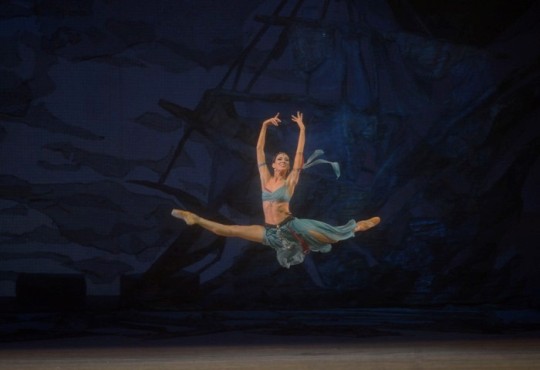
Caption: Mariinsky dancers are renowned for their impeccable technique and their focus on storytelling.
Credit: Viktoria Tereshkina in Le Corsaire by Valentin Baranovsky ™ State Academic Mariinsky Theatre
Scene 2: The Slave Market
From his powerful throne in the marketplace, the sultan Seid Pasha is eager to add young women to his harem. Lankedem is equally enthusiastic to fill the sultan’s wish and sells Medora’s friend Gulnara to him. Then, just as Medora is brought in, another bidder enters the market area—the pirate Conrad in disguise. When Seid Pasha confronts Conrad, the other corsairs throw off their cloaks, seize the evil Lankedem, and rescue the women. The Seid Pasha is furious at the useless Turkish patrol.

Caption: Pas (incidental dance variations) are common in Petipa ballets. While these dance variations might not move the plot forward, they still help the audience better understand the characters.
Credit: David Zaleyev in Le Corsaire by Natasha Razina ™ State Academic Mariinsky Theatre
Act II: The Corsairs’ Cave
The corsairs cheer the rescued women as well as the money they stole from the sultan. In celebration, Medora dances with Conrad and his friend Ali. The other women, however, express to Medora their desire to return home to their villages. Birbanto wants the women to stay, but Conrad is convinced by Medora to take the women home. Lankedem watches this conflict grow between Conrad and Birbanto. In exchange for his freedom, he offers Birbanto a sleeping potion. The plan is for Birbanto to pour the potion on a bouquet of flowers and give it to Medora. Medora passes the flowers to Conrad to thank him for his chivalry. Conrad falls asleep as Lankedem abducts Medora and he escapes the cave.
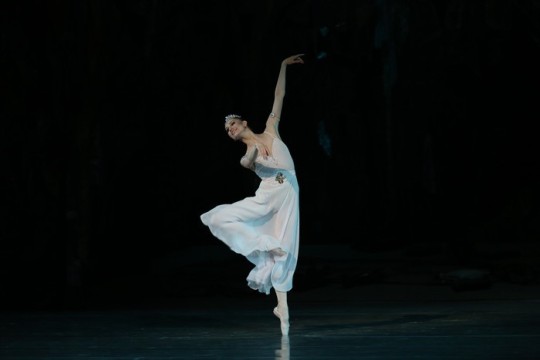
Caption: Medora is considered the most beautiful woman on the island; her movements are graceful and virtuosic.
Credit: Oxana Skorik in Le Corsaire by Natasha Razina ™ State Academic Mariinsky Theatre
Act III: The Seid Pasha’s Harem
Lankedem brings Medora to Seid Pasha’s harem, where he eagerly buys her from the slave trader and celebrates his new prize in his “garden of beauties.” Suddenly, mysterious pilgrims enter the palace and are invited to join the evening prayer. But Medora recognizes the visitors to be the corsairs, once again in disguise. The pirates surprise attack Lankedem’s patrol and Conrad saves Medora once and for all.
Epilogue
Medora, Conrad, and their friends sail toward their next adventure.
Check This Out…
Everything about this production is grand—from the spectacular sets and ornate costumes to the challenging choreography and large cast of dancers. The intricate plot calls for such grandeur, but it is also a famous quality of the Mariinsky company itself. Let’s take a closer look at what makes this production so impressive.
What to Look for:
SETS
The sets in Le Corsaire feature spectacular backdrops, curtains, and panels that set the scene without taking up the dancers’ real estate on the stage. There are a couple of scenes (including the slave auction) where there is a small platform on stage. But for the most part, the stage is wide open. This allows for a large number of dancers to be on stage and for them to perform dynamic, traveling choreography. This is particularly noticeable in the opening of Act II where the corsairs and women are celebrating.

Caption: A scene inside the elaborate cave setting.
Credit: Viktoria Tereshkina & Andrei Yermakov in Le Corsaire by Valentin Baranovsky ™ State Academic Mariinsky Theatre
COSTUMES
The costume design in Le Corsaire fuses Eastern-inspired apparel like harem pants and intricately wrapped stomach baring tops, with more traditional ballet apparel and accessories, including grand tutus and leotards and tights. Both the men and the women are dressed from head to toe. Headpieces and hats, facial hair and wigs, jewelry, and specially crafted shoes all reinforce characterization in Le Corsaire.
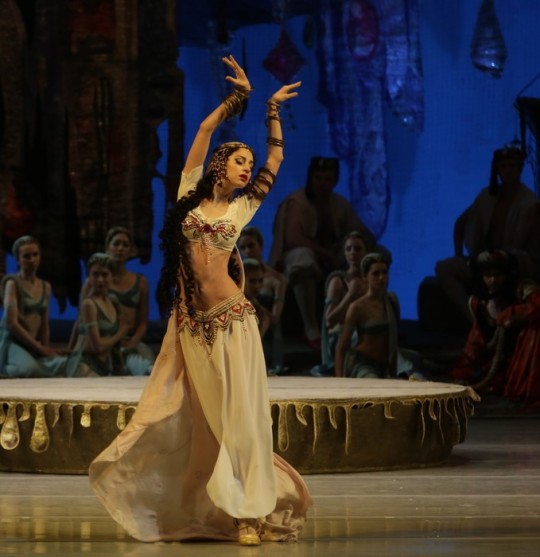
Caption: The costumes in Le Corsaire are extremely detailed and ornate—from the dancer’s headpiece and hairstyle to the pattern on her shoes.
Credit: Olga Belik in Le Corsaire by Natasha Razina ™ State Academic Mariinsky Theatre
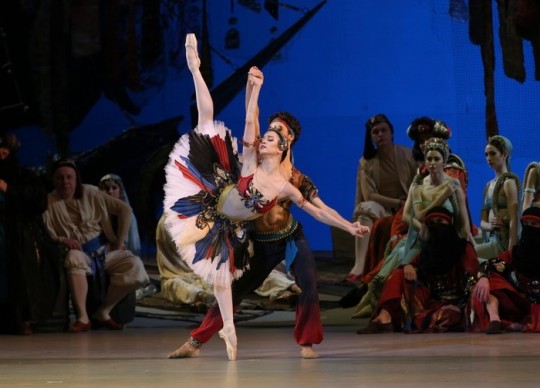
Caption: The costume design fuses traditional ballet tutus and pointe shoes with more Eastern inspired apparel.
Credit: Renata Shakirova & David Zaleyev in Le Corsaire by Natasha Razina ™ State Academic Mariinsky Theatre
CHOREOGRAPHY
Le Corsaire features both virtuosic choreography as well as elaborate pantomime. In fact, the character of Conrad initially didn’t dance at all—he only acted through pantomime.
Pay attention to the height of their jétes (zhuh-TAYS, jumps), intricate pirouettes (peer-WET, whirls or spins sequences), and effortless athleticism. Additionally, the corps de ballet (core duh bah-LAY, dancers in a company that perform as a group) demonstrates its unity of style.
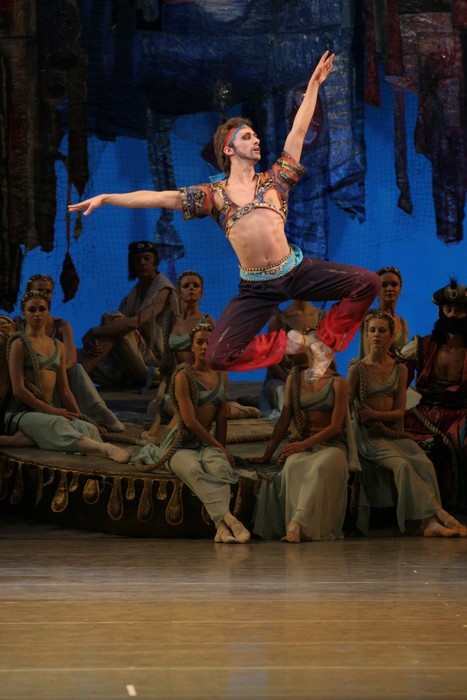
Caption: Years of training allows this dancer to travel through the air with amazing flexibility and height, making this difficult jump look effortless.
Credit: Philipp Stepin in Le Corsaire by Natasha Razina ™ State Academic Mariinsky Theatre
Additionally, Mariinsky dancers have distinguished themselves for their beautiful port de bras (pawr duh BRAH, technique of moving arms gracefully) and epaulement (ay-pohl-MAHN, placing of the shoulders and head). This meticulous attention to expression, fluidity, and detail gives a sense of aristocratic elegance.

Caption: The corps de ballet often works as a backdrop to the principal dancers.
Credit: Renata Shakirova in Le Corsaire by Natasha Razina ™ State Academic Mariinsky Theatre
The female dancers don’t always wear pointe shoes. They perform the more folkloric choreography in character shoes with a short heel.
Pantomime is a major element of Le Corsaire. It often helps to set the scene but is also incorporated into much of ballet choreography. For example, watch how Seid Pasha’s movements and gestures tell much about his intentions. Another dramatic moment of pantomime is when Conrad smells the bouquet of poisoned flowers at the end of Act II.
What to Listen for:
The score for Le Corsaire is a hodgepodge of tunes from many ballet composers, the result of scenes added over many years by Petipa. The “legend” is that ballerinas would often demand “a special solo” be added whenever they entered a production. Over time, each favorite solo became part of the standard version. In fact, ballets like Corsaire, (which didn’t start with a strong central score like Swan Lake and The Sleeping Beauty), were often subject to these kinds of musical additions.
Listen closely. Some music seems more Eastern Greek-inspired with accents from tambourines and flutes while other compositions sound like they may have come from another ballet like Swan Lake or The Sleeping Beauty.
What to Think About:
Le Corsaire has been performed internationally for over 250 years. Why do you think it remains so popular?
How is Le Corsaire similar to ballets you might have seen in the past? Can you make a list of qualities common among Petipa’s ballets or other classical ballets?
“Seeing a ballet” means more than simply watching dancers dance. A ballet is a total theatrical production with all parts working together, from the sets and costumes to the music and choreography. Think about how seeing Le Corsaire has changed your perception of ballet.
Let’s Talk About Shoes
In Le Corsaire, the ballerinas perform in both pointe shoes and heeled shoes. For some background info, here’s a bit of history behind the evolution of the ballet shoe.
Ballet and pointe shoes might seem inseparable today, but the art of ballet actually came about 200 years before ballerinas began dancing on their tiptoes. The Royal Academy of Dance was founded in France by King Louis XIV in the mid-seventeenth century. While ballet was practiced all throughout Europe, this Academy helped codify the language of the art form (which is why ballet terminology is in French). As ballet grew out of the social court dances, both male and female dancers wore heeled shoes (as you’ll see many dancers wear in the start of Act II). As you can imagine, heels inhibited a lot of movement. The heel was “dropped” in the early eighteenth century; the more formal shoe allowed for greater articulation of the foot (think of demi-pointe/soft ballet slippers that we have today).
By the late eighteenth century, choreographers began experimenting with wires and harnesses to elevate dancers from “mortal to ethereal.” Dancers also began stuffing their shoes with padding to get higher and higher on relevé (reh-luh-VAY, a raised body). Soon after, alterations were made to the shoes themselves to make this toe work more possible. The pointed-tip shoes were swapped with a sturdy front platform, or a layered fabric “box” to encase the toes, and a stiffer (but silent) sole. What we consider “modern day” pointe shoes are even stronger and sturdier than those early versions.
Surprisingly, the pointe shoe has remained relatively unchanged over the past 200 years despite the increasing demands of modern ballet dancing. A professional ballerina can wear up to 120 pairs of pointe shoes in a year and will often “alter” her shoes depending on a particular role (breaking them in more or stiffening them to last longer). Dance shoe companies provide the pointe shoes—the tools for the art—but it is often the dancer’s responsibility to mold and shape the shoes to fit her needs (and to care for her feet with tape, toe pads, etc.).
Learn more about the pointe shoe with this ARTSEDGE resource.
Take Action: Tell Your Story
Classical ballets were generally based off well-known fairy tales, fables, and folklore. Some examples are The Sleeping Beauty, Romeo and Juliet, and Swan Lake. Le Corsaire follows this model in the story elements of a shipwreck, a sleeping potion, and a happily-ever-after ending.
Think of a well-known story you especially enjoy—anything from the Three Little Pigs to Spider-Man. Either by yourself or with a group of classmates or friends, tell your story through movement using choreography and/or pantomime. Like a game of charades, communicate your tale without speaking. If you choose to present your work to your class or family, see if they can guess the story you’ve chosen to tell.
EXPLORE MORE
Go even deeper with the Le Corsaire Extras.
-
Top Photo: Le Corsaire by Valentin Baranovsky™ State Academic Mariinsky Theatre
Writer: Mary Callahan
Content Editor: Lisa Resnick
Logistics Coordination: Katherine Huseman
Producer and Program Manager: Tiffany A. Bryant
-

David M. Rubenstein
Chairman
Deborah F. Rutter
President
Mario R. Rossero
Senior Vice President
Education
Support for Ballet at the Kennedy Center is generously provided by Elizabeth and C. Michael Kojaian.
International Programming at the Kennedy Center is made possible through the generosity of the Kennedy Center International Committee on the Arts.
Major support for educational programs at the Kennedy Center is provided by David M. Rubenstein through the Rubenstein Arts Access Program.
Kennedy Center education and related artistic programming is made possible through the generosity of the National Committee for the Performing Arts.
© 2019 The John F. Kennedy Center for the Performing Arts
0 notes